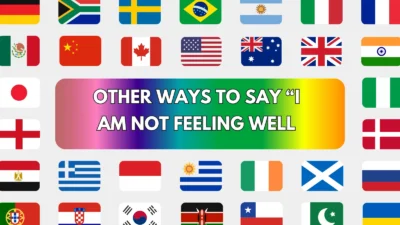Using words like “Firstly,” “Secondly,” and “Thirdly” is a classic way to organize points in writing or speech. However, overusing them can make your sentences sound mechanical or overly formal. If you want your writing or presentations to sound more natural, smooth, and engaging, there are plenty of alternatives to express sequence and order without losing clarity.
Here are 25 other ways to say “Firstly, Secondly, and Thirdly”, each with its meaning, detailed explanation, scenario example, best use, and tone.
1. To begin with
Meaning: Introduces the first point in a discussion or explanation.
Detailed Explanation: A smooth, conversational way to start an argument or list.
Scenario Example: To begin with, we need to understand the customer’s main needs.
Best Use: Essays, speeches, reports.
Tone: Clear, professional.
2. First of all
Meaning: Signals the first and most important point.
Detailed Explanation: Common in both spoken and written English for emphasis.
Scenario Example: First of all, I want to thank everyone for their hard work.
Best Use: Meetings, introductions, explanations.
Tone: Friendly, structured.
3. In the first place
Meaning: Introduces a reason or foundational idea.
Detailed Explanation: Works well when explaining cause and effect.
Scenario Example: In the first place, we shouldn’t have ignored the early warnings.
Best Use: Formal writing or persuasive arguments.
Tone: Logical, reflective.
4. For starters
Meaning: A casual way to introduce the first idea.
Detailed Explanation: Great for informal or conversational contexts.
Scenario Example: For starters, we need to update the website design.
Best Use: Speech, friendly discussions, blogs.
Tone: Relaxed, conversational.
5. To start with
Meaning: Introduces an opening point before continuing.
Detailed Explanation: Sounds natural in both writing and conversation.
Scenario Example: To start with, let’s focus on improving our communication.
Best Use: Informal writing, team meetings.
Tone: Neutral, simple.
6. The first point is
Meaning: Directly identifies your first argument or reason.
Detailed Explanation: Straightforward and professional.
Scenario Example: The first point is that we need better data security.
Best Use: Reports, essays, debates.
Tone: Formal, precise.
7. First and foremost
Meaning: Emphasizes the most important point before others.
Detailed Explanation: Great for highlighting priority or value.
Scenario Example: First and foremost, safety should always come first.
Best Use: Presentations, persuasive writing.
Tone: Strong, serious.
8. Next
Meaning: Moves smoothly to the following point.
Detailed Explanation: Simple and versatile for transitions.
Scenario Example: Next, we’ll discuss the marketing strategy.
Best Use: Formal or informal contexts.
Tone: Clear, direct.
9. Then
Meaning: Indicates the sequence of ideas or events.
Detailed Explanation: Commonly used in storytelling or step-by-step explanations.
Scenario Example: First, gather your tools. Then, follow the instructions carefully.
Best Use: Instructions, guides, conversations.
Tone: Neutral, straightforward.
10. After that
Meaning: Continues the flow from one idea to the next.
Detailed Explanation: Smoothly connects sequential points.
Scenario Example: We finalized the design, and after that, we started production.
Best Use: Process explanations, narratives.
Tone: Smooth, coherent.
11. Following that
Meaning: Formal alternative for “after that.”
Detailed Explanation: Perfect for business writing or reports.
Scenario Example: Following that, we conducted a detailed market analysis.
Best Use: Reports, essays, official communication.
Tone: Professional, polished.
12. Secondly
Meaning: Traditional word for the second point.
Detailed Explanation: Works in structured or academic writing.
Scenario Example: Secondly, we must address customer feedback promptly.
Best Use: Essays, presentations.
Tone: Formal, organized.
13. Another point to consider
Meaning: Introduces an additional argument or idea.
Detailed Explanation: Natural and flexible for smooth transitions.
Scenario Example: Another point to consider is how this will affect costs.
Best Use: Analytical or persuasive writing.
Tone: Thoughtful, balanced.
14. Moving on
Meaning: Shifts attention to the next topic.
Detailed Explanation: Great for flow in presentations or speeches.
Scenario Example: Moving on, let’s discuss our next quarter’s goals.
Best Use: Verbal communication, slides, essays.
Tone: Smooth, conversational.
15. As for the next point
Meaning: Signals transition between ideas.
Detailed Explanation: Keeps the structure clear in professional writing.
Scenario Example: As for the next point, let’s analyze customer retention.
Best Use: Reports, essays, or structured discussions.
Tone: Formal, cohesive.
16. The next step is
Meaning: Indicates a sequential process or plan.
Detailed Explanation: Ideal for instructional or strategic writing.
Scenario Example: The next step is to test our hypothesis.
Best Use: Business, technical, or academic writing.
Tone: Clear, logical.
17. Secondly (or Secondly speaking)
Meaning: Introduces the second idea or reason.
Detailed Explanation: Common in academic and structured writing.
Scenario Example: Secondly, we should consider the environmental impact.
Best Use: Essays, formal speeches.
Tone: Academic, professional.
18. Furthermore
Meaning: Adds another reason or supports a previous point.
Detailed Explanation: Sounds professional and connects ideas smoothly.
Scenario Example: Furthermore, this method improves cost efficiency.
Best Use: Reports, essays, formal writing.
Tone: Formal, cohesive.
19. Moreover
Meaning: Adds an additional idea with emphasis.
Detailed Explanation: Slightly more formal than “furthermore.”
Scenario Example: Moreover, it enhances long-term sustainability.
Best Use: Research papers, academic writing.
Tone: Formal, academic.
20. In addition
Meaning: Adds extra information or another point.
Detailed Explanation: Works well to expand on previous arguments.
Scenario Example: In addition, we’ll explore potential partnerships.
Best Use: Reports, presentations.
Tone: Polite, formal.
21. Another important point
Meaning: Highlights a new yet significant idea.
Detailed Explanation: Keeps emphasis while moving to the next concept.
Scenario Example: Another important point is improving user experience.
Best Use: Professional communication.
Tone: Objective, organized.
22. Also
Meaning: Simple way to add a related idea.
Detailed Explanation: Works in both casual and professional writing.
Scenario Example: We improved the design. Also, the speed has doubled.
Best Use: Everyday writing, conversations.
Tone: Neutral, easy-going.
23. Thirdly
Meaning: Introduces the third argument or point.
Detailed Explanation: Common in academic or structured writing.
Scenario Example: Thirdly, we need to train our staff properly.
Best Use: Essays, reports, structured documents.
Tone: Formal, academic.
24. Lastly
Meaning: Introduces the final point.
Detailed Explanation: Great for wrapping up a series of arguments.
Scenario Example: Lastly, I’d like to thank everyone for their support.
Best Use: Speeches, essays, reports.
Tone: Conclusive, polite.
25. Finally
Meaning: Marks the conclusion or last item in a sequence.
Detailed Explanation: A versatile and natural closing transition.
Scenario Example: Finally, let’s summarize our key takeaways.
Best Use: Presentations, summaries, essays.
Tone: Concluding, smooth.
Conclusion
Using “Firstly, Secondly, and Thirdly” works in structured or academic writing, but switching them up can make your tone sound more natural and engaging.
Alternatives like “To begin with,” “Next,” “Furthermore,” and “Finally” help your writing flow better and keep your audience interested. Choose simpler or more formal expressions based on your context — and you’ll sound confident, polished, and professional in every situation.



